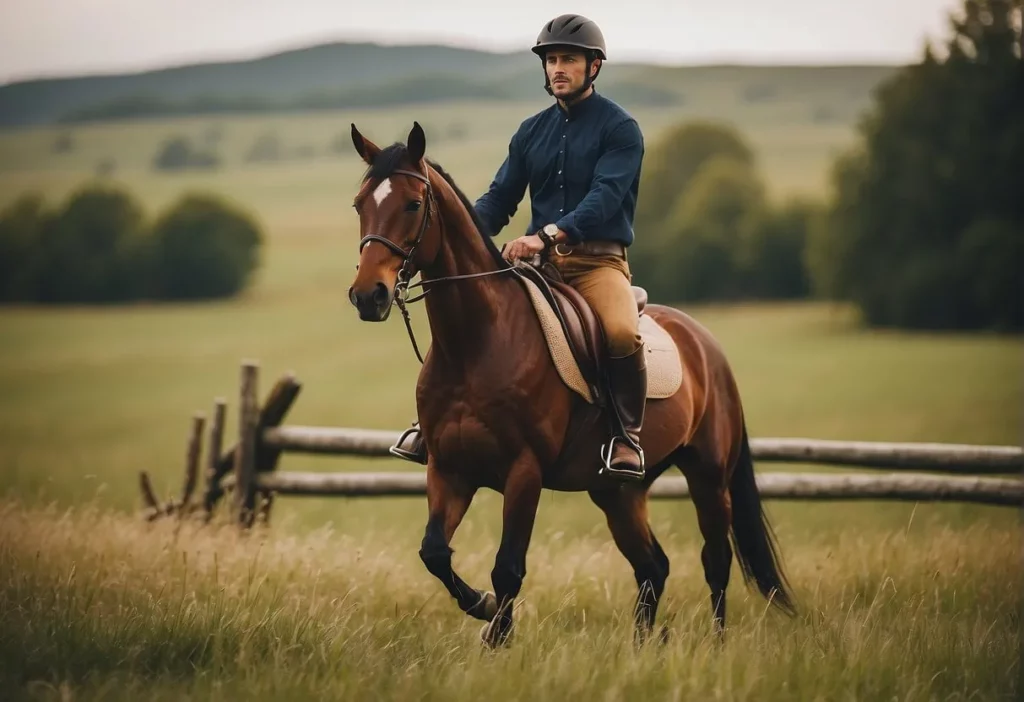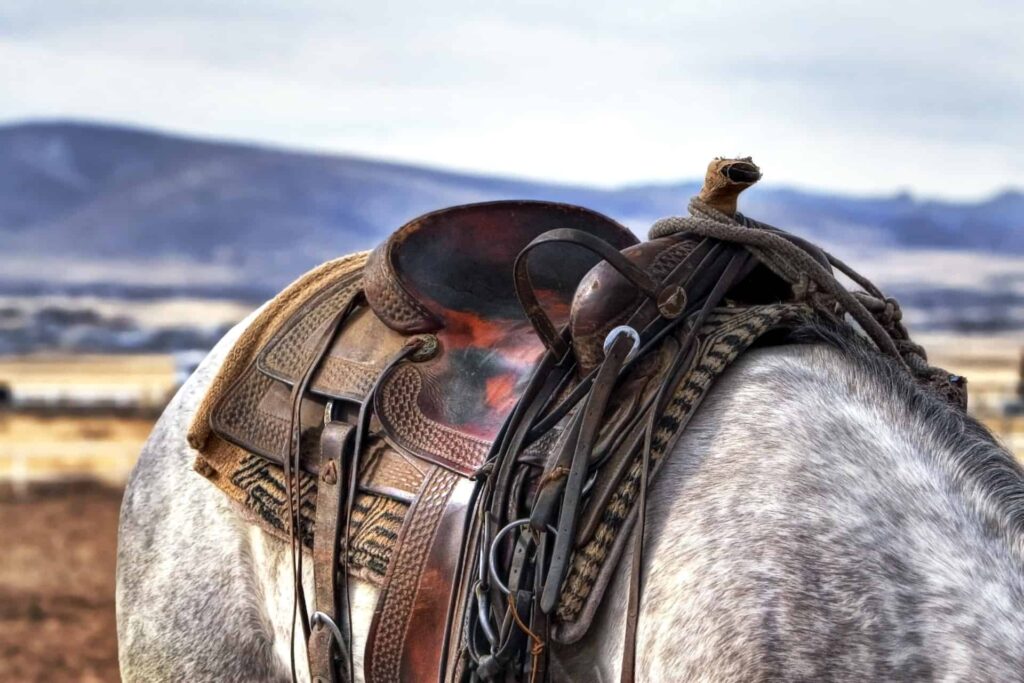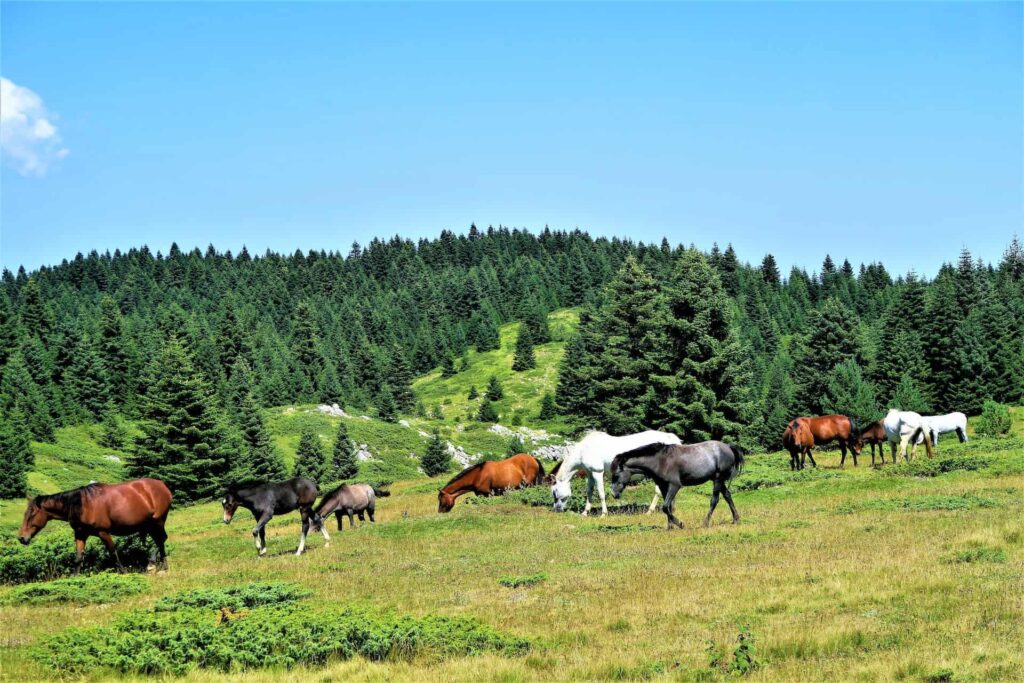Selecting the appropriate attire for horseback riding is not just a matter of style but safety and comfort as well.
The right clothing helps protect riders from common injuries while allowing the freedom of movement necessary to control the horse and maintain proper riding posture. Understanding the basics of what to wear is fundamental for any rider, whether they are just starting or are experienced equestrians.
It can significantly enhance the riding experience. Riding wear starts with a helmet, which is a crucial item for preventing head injuries. Along with safety, choosing clothing that is comfortable and suitable for the weather conditions is important. Tightly fitted clothes such as breeches or jodhpurs paired with a comfortable shirt allow for ease of movement without the risk of tangling in equipment.
Boots with a slight heel prevent the foot from slipping through the stirrup. When it comes to materials, durability and flexibility are key. Fabrics should allow for breathability while being sturdy enough to withstand the rigors of riding.
Key Takeaways
- Proper attire is crucial for safety, comfort, and freedom of movement while horseback riding.
- Helmets are essential for preventing head injuries, and boots with heels enhance safety by preventing stirrup slips.
- Clothing should be durable and breathable to allow for flexibility and ease of movement.
Understanding Horseback Riding Basics

Horseback riding is a diverse activity that can range from English to Western disciplines, including trail riding and beach excursions.
Each style has its unique attire, but some basics remain consistent across all forms.
When riding English, one typically wears breeches, tall boots, and a helmet. The attire helps in maintaining close contact with the horse and allows for precise movements. English disciplines often include Dressage, Show Jumping, and Eventing.
In contrast, Western riding calls for jeans, cowboy boots, and a wide-brimmed hat. This style is commonly associated with ranch work, rodeo, and Western pleasure riding. The clothing is durable and designed for long hours of riding with comfort.
For those who love trail riding, comfort trumps fashion. It necessitates comfortable jeans or breeches, suitable boots, and a helmet. Layers are advisable for varying weather conditions.
Horseback riding on the beach has its specific requirements too. Riders need to consider the sandy and potentially wet environment. Beach horseback riders often wear lightweight and easy-to-clean boots or old sneakers and half-chaps over breeches or jeans protect the rider’s legs from irritation caused by sand.
| Riding Style | Attire Required |
|---|---|
| English | Breeches, Tall Boots, Helmet |
| Western | Jeans, Cowboy Boots, Hat |
| Trail Riding | Comfortable Jeans/Breeches, Boots, Helmet |
| Beach Riding | Lightweight Boots/Sneakers, Half-chaps |
Safety is important, so protective gear like helmets should be worn regardless of the riding discipline. Riders should also make sure their clothing provides free movement and stability while on the horse.
The ultimate goal is to achieve a balance between practicality, safety, and adherence to the chosen riding discipline’s traditions.
Essential Riding Wear
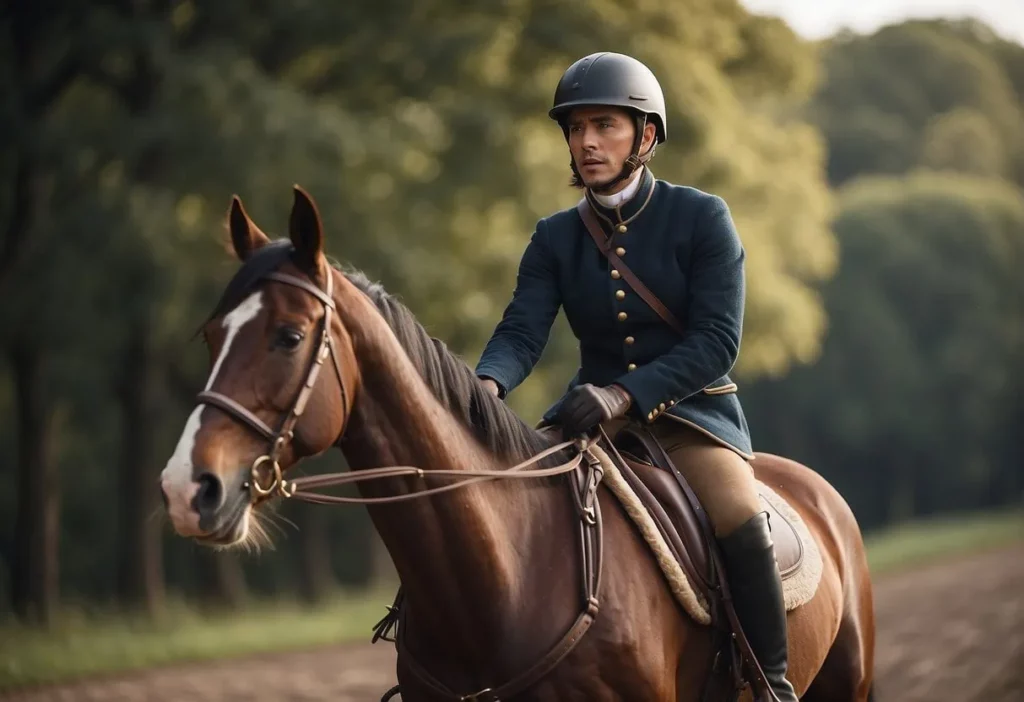
Selecting the right clothing is crucial for safety and comfort while horseback riding. Each piece serves a specific purpose and should be chosen with care.
Headgear
Horseback riders should always wear a helmet that meets ASTM standards and is certified by the Safety Equipment Institute (SEI).
A proper riding helmet protects against head injuries and should fit snugly without obstructing vision.
Upper Body Attire
Riders need a shirt that allows for easy movement.
A long-sleeve shirt or jacket, especially a riding jacket, offers protection from the sun and brush.
Cotton or moisture-wicking fabric ensures breathability and comfort.
Lower Body Apparel
Jeans or riding pants like breeches or jodhpurs are standard.
They should be made of a comfortable material to prevent chafing and have a sturdy waistband to support the correct posture.
Footwear Choices
Boots specifically designed for horseback riding, such as paddock boots or tall boots, are essential.
They should have a small heel to prevent the foot from sliding through stirrups and be made of durable leather for longevity.
Hand Protection
Gloves, particularly riding gloves, grip aid and protect the hands from blisters.
They should fit well and allow for dexterity in handling reins.
Additional Gear
For lower leg protection and additional stability, riders often wear chaps or half chaps.
Cowboy chaps are also an option for additional coverage.
Riding Accessories
Practical accessories include belts to keep pants in place and socks, preferably boot socks, designed to provide cushioning inside the boots.
Protective Equipment
A vest or body protector can be worn for additional safety to safeguard against falls and impacts.
They should be made of breathable material with padding in critical areas.
Tips for Comfort
Riders should consider layering clothing for adjustable comfort based on the weather, with a fleece or similar material for warmth.
Breathable, comfortable apparel with patches for reinforcement in high-friction areas is recommended.
Choosing the Right Materials
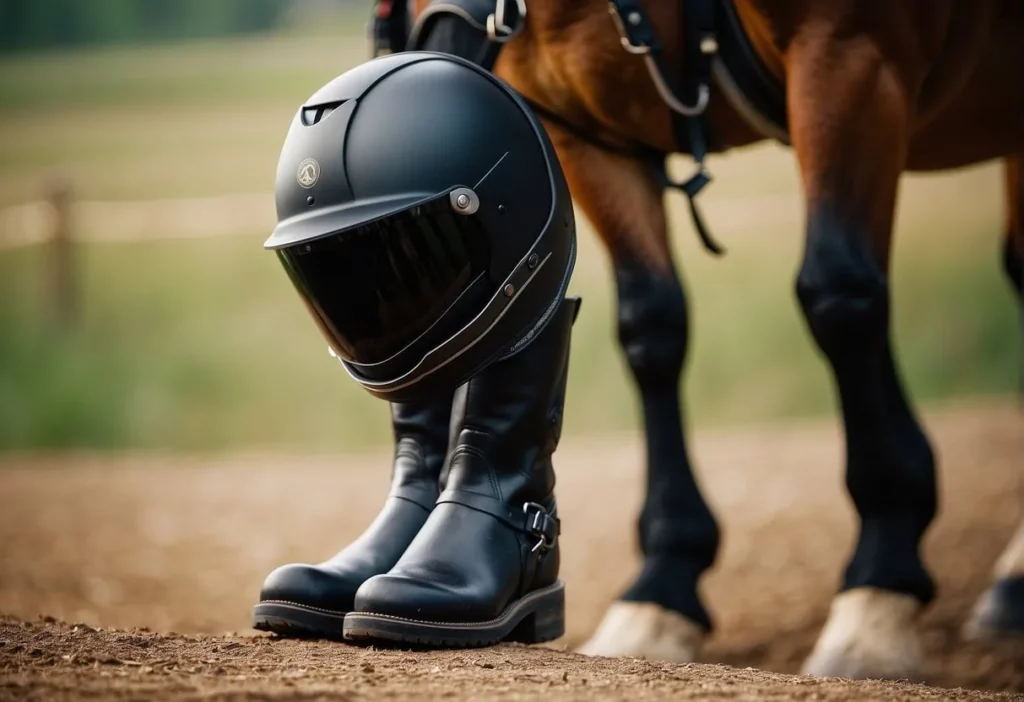
When selecting materials for horseback riding, durability, and comfort are paramount.
One should opt for leather for boots and saddles due to its sturdiness and ability to conform to the rider’s shape over time.
For clothing, cotton is favored for its softness and breathability, but it may not provide enough protection against the elements.
For outdoor riding, materials should be waterproof to guard against the weather.
Moisture-wicking fabrics are beneficial as they draw sweat away from the skin, ensuring the rider stays dry and comfortable.
Similarly, breathable fabrics are essential to maintain comfort during extended periods of riding.
They allow air circulation, preventing overheating and discomfort.
| Material Type | Beneficial For | Properties |
|---|---|---|
| Leather | Boots, Saddles, Gloves | Durable, Molds to Shape |
| Cotton | Casual Riding Clothes | Soft, Breathable |
| Synthetic | Performance Gear | Moisture-Wicking, Durable |
| Waterproof | Outerwear | Protects from Elements |
What to Avoid Wearing
When preparing for horseback riding, one must carefully choose apparel that ensures safety and comfort.
He or she should avoid wearing anything loose-fitting or flowy, like dresses or skirts, as these could snag on equipment or impair one’s ability to control the horse securely.
Shorts are not recommended, as they offer little protection against saddle friction or the elements.
Similarly, inappropriate footwear can pose significant risks; thus, sandals, flip-flops, open-toed shoes, and high heels are unsuitable.
Such footwear lacks the necessary stability, and an open design does not shield the feet from potential injuries.
For safety reasons, it’s critical to stay clear of tennis shoes with straps or laces that could come undone and get caught in stirrups.
Riders should opt for boots with a small heel to prevent their foot from slipping through the stirrup, thereby enhancing their safety.
Clothing with loose straps or prominent accessories can entangle in equipment; therefore, these items are best left out of the riding attire.
One’s ensemble should prioritize practicality and protection; after all, horseback riding is a rigorous activity where the right gear makes all the difference.
Considerations for Special Riding Events
When preparing for special riding events such as jumping, eventing, and dressage, attire is not only a matter of tradition but also of safety and functionality.
Riders must adhere to the specific dress code associated with each event. The dress code often reflects the equestrian fashion trends while ensuring practicality.
For jumping competitions, attire typically consists of a short riding jacket, white shirt, stock tie, white breeches, and black tall boots. Helmets are mandatory, and a safety vest may be worn for additional protection.
Eventing requires riders to have different outfits for each phase. The dressage phase mirrors that of pure dressage competitions. However, the cross-country phase allows for more practical, protective gear, including body protectors and helmets with a fixed peak. Bright colors are often chosen for visibility.
In dressage, riders usually wear a long, dark-colored tailcoat, white breeches, a white stock shirt with a stock tie, tall dress boots, and a top hat. More frequently, a dressage helmet is worn for safety. Gloves are also worn and are traditionally white.
| Event | Jacket | Shirt | Breeches | Boots | Headgear |
|---|---|---|---|---|---|
| Jumping | Short, dark | White with stock tie | White | Tall, black | Safety helmet |
| Eventing | Phase-dependent | White | Varies | Varies | Helmet, body protector |
| Dressage | Tailcoat, dark | White with stock tie | White | Tall, black | Top hat or helmet |
Shopping for Riding Attire
When embarking on the journey to invest in quality horseback riding gear, one’s shopping list should include essentials such as a riding shirt and riding jacket.
Beginning with the upper body, a suitable riding shirt is key; it should provide comfort and flexibility. Options range from technical fabrics that wick away sweat to traditional cotton blends, with prices varying accordingly.
For colder weather, adding a riding jacket to one’s attire becomes a necessity. Riders should look for jackets that offer warmth without restricting movement. While these can be more expensive, the investment ensures a safer and more comfortable experience. They come in a variety of materials, from lightweight synthetics to insulated down.
| Item | Features | Price Range |
|---|---|---|
| Riding Shirt | Breathable, Flexible | $25 – $80 |
| Riding Jacket | Warm, Non-restrictive | $50 – $200+ |
As for lower body attire, one mustn’t underestimate the importance of well-fitting riding pants or jodhpurs that allow for ease of motion and can withstand the rigors of riding. Protective gear, such as helmets and boots, are imperative for safety and often mandatory at riding schools.
When shopping for riding attire, consider visiting equestrian-specific retailers or online stores where advice and a broad range of products are readily available.
Remember, the goal is functionality coupled with comfort, ensuring each ride is a pleasurable experience.
Maintaining Riding Attire
When it comes to horseback riding, wearing the proper attire is just as important as maintaining it. Ensuring that clothing is durable and made from quality materials can save riders from frequent replacements and provide better protection.
Materials: Riders should look for attire made from strong fabrics. Leather, for instance, is renowned for its durability, especially in boots and gloves. Breeches should be made of breathable, stretchable, yet resilient fabrics to maintain comfort and withstand the rigors of riding.
Cleaning: Regular cleaning is crucial for all riding attire. Leather items should be cleaned with a suitable leather cleaner and conditioned to prevent cracking. Fabric items like breeches and shirts usually have specific washing instructions; following these carefully will prolong their life.
- Daily checks: After every ride, brush off any dirt or debris from your clothing.
- Deep clean: Schedule a monthly deep clean for all riding attire.
Waterproofing: For those who ride in variable weather, waterproof gear is a necessity. Jackets and boots should be treated with a waterproofing agent. Reapply these treatments regularly to maintain effectiveness.
| Attire Item | Maintenance Task | Frequency |
|---|---|---|
| Leather Boots | Clean and condition | After every ride / Monthly |
| Breeches | Wash according to label | After use |
| Riding Jacket | Waterproofing treatment | Seasonally / As needed |
Frequently Asked Questions
The appropriate attire for horseback riding is crucial for safety, comfort, and ease of movement. Whether you’re a first-time rider or an experienced equestrian, knowing what to wear in different riding conditions is essential.
What type of footwear is appropriate for horseback riding?
Riders should wear sturdy, closed-toe shoes with a small heel to prevent the foot from slipping through the stirrup. Boots are specifically designed for riding, and they provide the best support and protection.
What should I wear for horseback riding in cold weather?
For cold-weather riding, layers are key. Start with a thermal base layer, and add insulated pants, and a warm, but flexible, jacket. Gloves and a woolen hat that fits under the helmet are also advisable for additional warmth.
What are the essentials for a first-time rider to wear when going horseback riding?
First-time riders should prioritize a well-fitting helmet, comfortable jeans or leggings without inner seams, and boots with a low heel. Gloves can offer a better grip and protect the hands.
What attire is recommended for horseback riding on the beach?
For beach riding, light-colored, breathable clothing is ideal to reflect sunlight and stay cool. Long-sleeved shirts provide sun protection, and sturdy trousers protect from saddle chafing. Sandals should be avoided.
What is the best clothing for horseback riding in hot weather?
When riding in hot weather, moisture-wicking fabrics are preferred. A lightweight, long-sleeved shirt will protect against the sun, and ventilated riding tights will help keep the rider cool.
How should I dress for a Western-style horseback riding session?
Western riders should opt for a long-sleeved shirt, jeans with a comfortable fit, and Western boots. A cowboy hat with a secure fit can provide sun protection, while a bandana may offer dust protection.
Last Updated on February 29, 2024 by Nate Dewsbury
